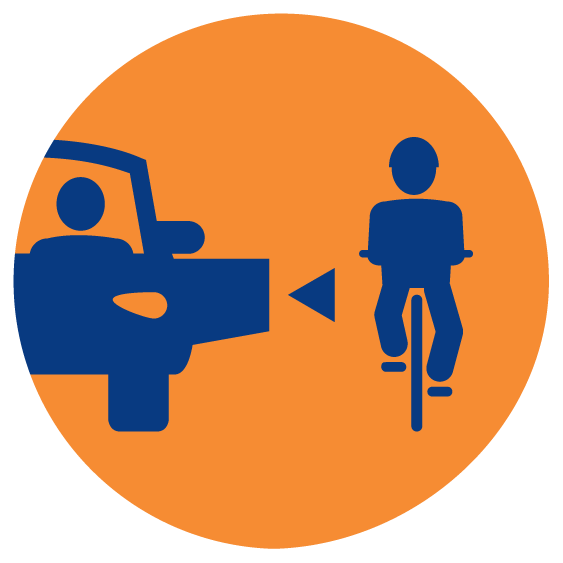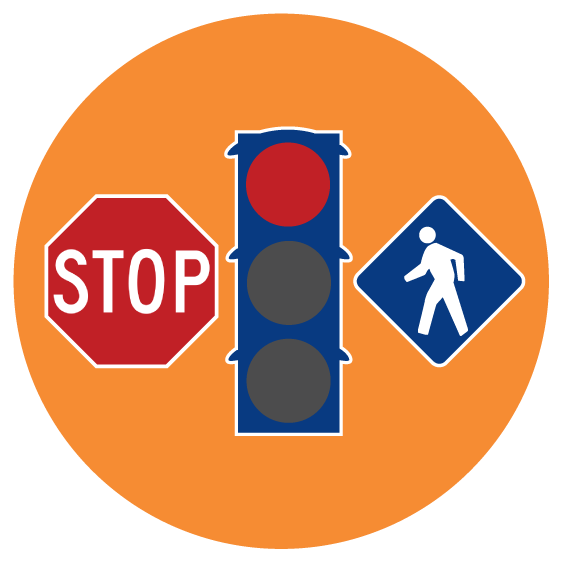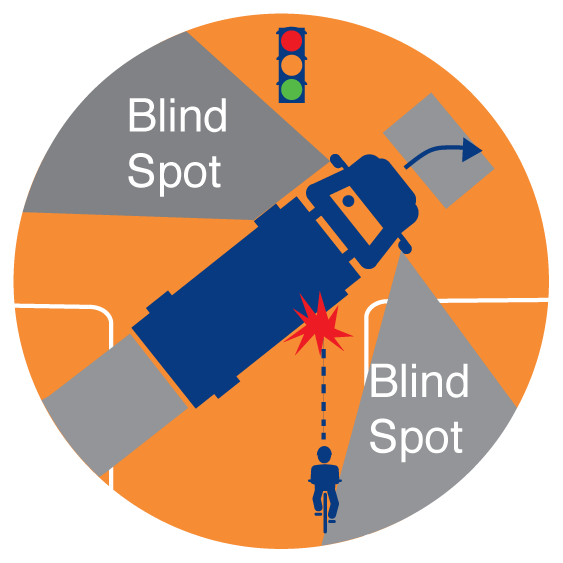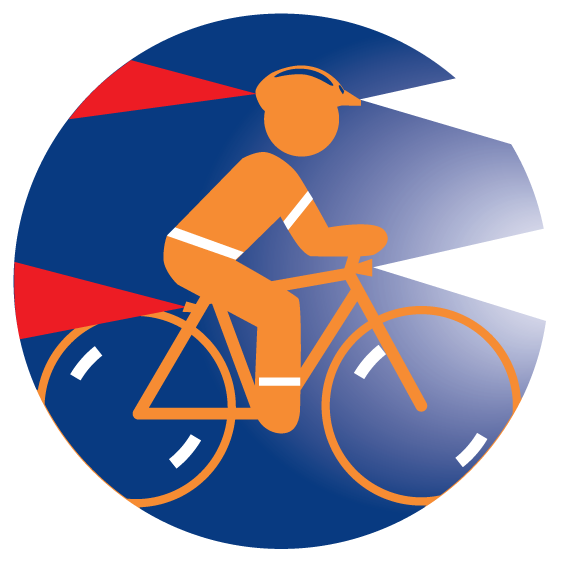Safety
Urban Cycling Safety Tips
Beware of doors. Leave 3 feet.

You are allowed full use of the road, so ride at least 3 feet from parked cars, even in traffic, even if this means you’re at the edge or outside of the bike lane. Do not assume that parked cars are empty, and do not assume that the driver will look before opening the door.
Follow the rules of the road. Yield to pedestrians.

Bikes are considered vehicles and are expected to follow all rules of the road.
Ride in the direction of traffic. Stay off sidewalks in business districts. Stop for all red lights and stop signs. When there are traffic signals, wait for the green light. The walk signal indicates that it is safe for pedestrians to cross the intersection. This signal is not for cyclists. Wait for the green light before proceeding through the intersection. Failure to follow the rules of the road creates dangerous situations for both you and others.
When there are no traffic signals you must yield to pedestrians. They have the right of way. Failing to yield may result in a fine.
Avoid blind spots.

Trucks, buses, and over-sized vehicles have large blind spots, particularly on the right. Avoid overtaking large vehicles. Stay visible to the drivers – if you can’t see the driver in the mirror, the driver can’t see you. The majority of cyclist fatalities in Boston have involved large vehicles.
The “right hook” can be extra dangerous. Cyclists can get seriously injured by large vehicles turning and not seeing cyclists. Take extra caution at intersections and avoid being to the right of large vehicles.
Wear a helmet and use lights.

Wear your helmet. Use lights, reflectors, and bright clothing to see and be seen. Lights are required by law in the time between ½ hour after sunset and ½ hour before sunrise. You must have at least one white light on the front, and one red light on the rear of your bike. You must have reflectors on your your pedals or on your ankles. You may use as many lights and reflectors as you wish.
Helmets are required for anyone 16 or younger. Everyone should wear a properly fitting helmet anytime they ride a bike.
Where to buy a helmet
You can purchase a helmet for $10 (pay by check) from LL-15 in the Kresge Building of the Harvard T.H. Chan School of Public Health or in HMS’ Parking Office at 180B Longwood Ave in room 132. They’re also available for $12 in the gift shop of Dana Farber Cancer Institute and for $10 in room 835 of the Smith Campus Center in Cambridge.
If your lose your helmet or it breaks while you’re at school, the HMS Parking Office (180B Longwood Ave, room 132) also has emergency rental helmets available upon request.
Make sure your helmet is properly fitted.

Helmets are not reusable. If you hit your head with some force while wearing a helmet, even if it doesn’t break, you should buy a new one.
Urban Cycling Guide
Harvard University has partnered with the City of Boston to promote a new Urban Cycling Safety Campaign!
Test your Bike-Q – Earn free gear
Boston loves cyclists, so we want to make sure you’re prepared for everything. Learn how to avoid common urban hazards. Know the rules of the road and proper cycling etiquette, too. Ride smart. Ride safe. And most of all, enjoy yourself.
As part of the campaign be sure to review safety tips, and check out a series of videos to learn about rules of the road and ways to improve your cycling skills.
Signaling 101
One of the best ways to stay safe is by behaving predictably. Following the rules of the road and signaling help cars, pedestrians and other cyclists understand what to expect from you and where you’re going.

Additional safety resources:
- Boston’s Urban Cycling Guide
- Boston Bikes Safety Campaign
- How to not get hit by cars
- Commuting tips
- How to ride your bike on a road with traffic (video)
- The Rights and Duties of Cyclists (video)
- Bike Safe Boston Blog
- Bike Laws and Rights (Mass Bike)
- How to lock your bike (video)
- How big is a truck’s blind spot? (video)
- Winter Riding Tips
Employees interested in learning about bicycle safety or repair techniques can take classes at any location and be reimbursed for expenses. Employees must verify eligibility prior to class registration by emailing commuterchoice@harvard.edu or calling (617) 384-7433.
Bike Crash 101
What to do if you’re in a crash
- Make sure you’re safe. If you’re lying in harm’s way and risk being further injured by oncoming traffic, try to get to a safe place until you can receive medical care. Otherwise, lie still until you or a medical professional can ensure you are not seriously hurt.
- Identify other parties to the crash, including witnesses. Get the vehicle’s license plate and the driver’s license, registration, and insurance information, if possible.
- Call the police and file a police report. Even if you don’t want to file charges against any other parties, this is important for documenting what happened. Making sure the city knows about the crash can help make that street or intersection safer in the future.
- Receive medical care, even if that just means getting checked out by your regular doctor.
- Get home safely. Do not try to ride your bike until you’re sure it’s structurally sound.
- Document damage to your bike — bike shops are well-practiced at providing damage estimates.
- Contact the other party’s insurance company.
- Consider hiring a lawyer.
What to do if you’ve caused a crash
- Make sure the other person is safe and call 911 if necessary. DO NOT LEAVE THE SCENE.
- Identify other parties in the crash and exchange contact information.
What to do if you see a crash
- Stop and make sure everyone is safe. If someone is hurt, call 911, try to keep traffic at bay, and DO NOT MOVE THEM.
- Stay until help arrives, if you can, and assist the injured party with getting in touch with their emergency contacts (if necessary).
- Identify parties to the crash and provide a witness statement to the police. Help to document any damage you see.
Reporting Bike Theft
STEP 1: File a report.
- If your bike is stolen from Harvard Longwood campus, call HUPD’s Longwood line (617-432-1212).
- If your bike is stolen in Harvard Cambridge campus, call HUPD’s Cambridge line (617-495-1212).
- If your bike is stolen off-campus, call your local police department’s non-emergency phone line.
- Brookline: (617) 730-2222
- Cambridge: (617) 349-3300
- Boston: (617) 343-4500
- Somerville: (617) 625-1600
It helps to know your bike’s serial number, make, model, and color. Also, think of all accessories that may have been on your bike, including a fix kit, basket or rack, lights, and saddle. Try to provide a photo of your bike, if possible.
STEP 2: Register your stolen bike on various internet databases.
Local and national registries include Bike Index.
STEP 3: Spread word of your stolen bike far and wide, preferably with photos.
Post on Boston Bike Party’s Community Facebook page. Put posters up around school. Let your friends on social media know and ask them to keep an eye out, especially if you have a unique or distinctive-looking bike.
STEP 4: Keep an eye out for your bike online.
Look through Craigslist postings, and set up Google alerts with information matching your bike.

